AI is merely a means to achieve the management agenda, not an end goal. Starting with the business issue each company faces, it is important to identify the scope of AI through clearly defined use cases. Furthermore, it is essential to develop schemes and environments that can properly utilize data, as well as create various functions, such as AI infrastructure and AI human resources, to ensure the sustainable application of AI.
In current times, not a day goes by without the keyword "AI" coming up in conversations with client management. While this indicates a growing interest, it may also suggest that many companies have yet to make as much progress as they aspire to in utilizing AI and are still only halfway there.
What is required to make good use of AI?

The position of AI in major Southeast Asian countries
- Singapore: Created a national AI strategy and promoted AI as a core technology. It leads Southeast Asia in both the number of AI-related papers and unicorn companies.
- Indonesia: Given the size of its economy and population, Indonesia holds significant potential for AI growth by setting "Stratnas AI" as a national AI strategy and actively promoting relative activities. Indonesia also ranks second for the number of AI-related unicorn companies, following Singapore.
- Vietnam: The number of AI-related research papers has increased in recent years. Vietnam is prioritizing the cultivation of highly specialized talent, including plans to establish an AI Specialization University.
- Malaysia: Establish the National AI Office (NAIO) as a central agency to promote AI activities. It aims to become a major player in AI worldwide.
Like other countries, Thailand also has created a national AI strategy and is promoting the application of AI in various fields. Chulalongkorn University has established an AI research institute, reflecting Thailand's commitment to AI research and innovation. The country is prioritizing AI training and human resource development with the goal of becoming the regional hub for AI in Southeast Asia. Additionally, in collaboration with the Ministry of Digital Economy and Society, Thailand is also promoting the
"Digital Thailand Plan", which aims to achieve sustainable development through the utilization of digital technology.
What these countries have in common is their focus on AI activities at the national level, recognizing it as a priority area for future investment. On the other hand, when looking at individual companies, the situation of their initiatives varies widely. Some companies are focusing on a specific area and moving forward with AI utilization but are running into issues from a governance perspective, while others are seeking advice from a data management perspective, which is a prerequisite for AI utilization. The issues vary from company to company. However, the most common inquiry we receive, despite companies not fully understanding AI, is how they can utilize AI to avoid falling behind their competitors. The keyword "AI" takes precedence in companies at this stage, leading to efforts that begin with vague expectations. As a result, their initiatives often lack long-term sustainability and end up being temporary.
Effective AI Utilization: Addressing Company-Specific Challenges
We are not dismissing the approach of evaluating which AI solutions and services from around the world are applicable to a company. However, each company has a unique corporate structure, situation, and varying priorities, including different levels of data cleansing and internal power dynamics.
Unless AI is aligned with the company's business Issues, management agendas, and on-site pain points as input and carefully considered in terms of business and operational areas, service offerings, and implementation methods, it will be difficult to effectively utilize AI in the medium to long term.
Management×AI
Currently, there is no AI solution that can generally address all purposes. Therefore, AI should be considered as a tool to help resolve specific challenges and align with your company's business issues and management agendas. Rather than starting an initiative with vague expectations, you need to narrow down the use case to a specific one and clearly define the impact and return on investments (ROI). If you do not do this, you will be unable to properly digest the results and outcomes of the PoC stage, which will eventually reach a dead end.
The path to utilizing AI
Utilizing AI cannot be achieved in one leap; it is necessary to gradually move forward with a step-by-step approach. The most common issue that companies face when utilizing AI is the quality of the input data. In particular, in recent years, as corporate portfolios have been transformed through mergers and acquisitions (M&A), including acquisitions and carve-outs, systems and data within companies have become more complex. This complexity has made it challenging to maintain unified data under unified rules. In order to achieve the expected results, it is necessary to increase the overall maturity of data management, including the collection and preparation of data necessary for analysis.
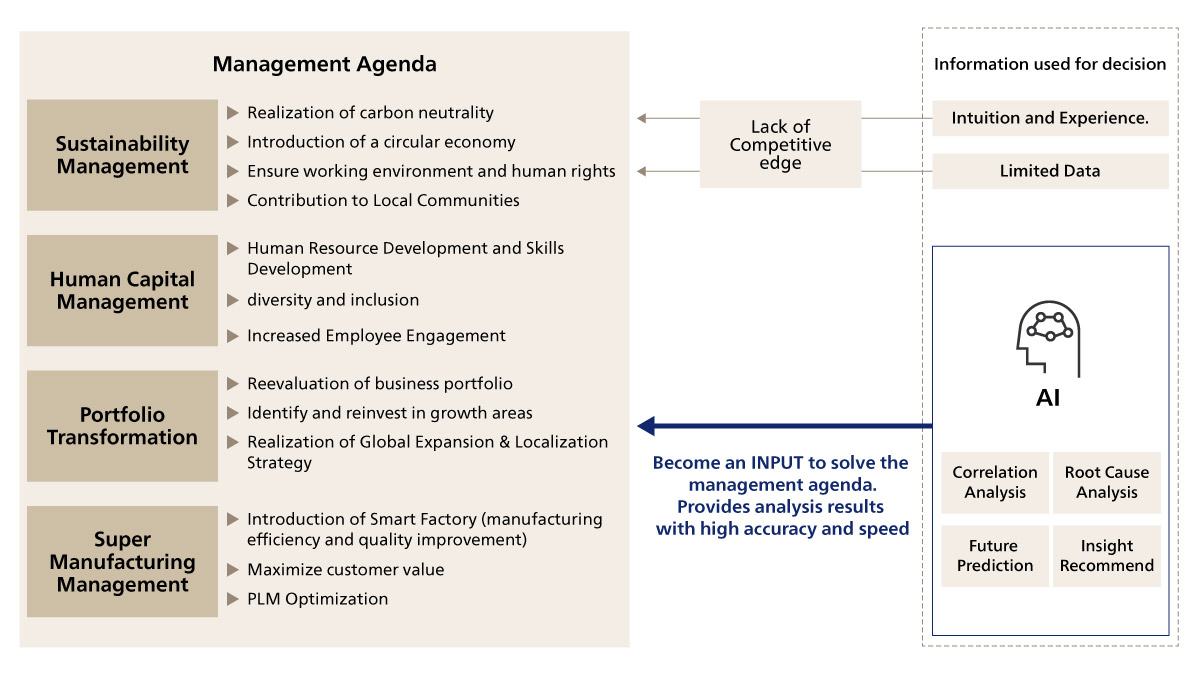
The effectiveness of AI utilization will vary greatly depending on its level of maturity. On the other hand, there are many cases where excessive focus on overall improvement delays the realization of benefits, causing the initiative to lose momentum and come to a halt. To avoid this, it can be important to narrow down to specific operations, systems, and data. Decisions should be based on each company's priority levels, taking an approach of "starting with what we can do."
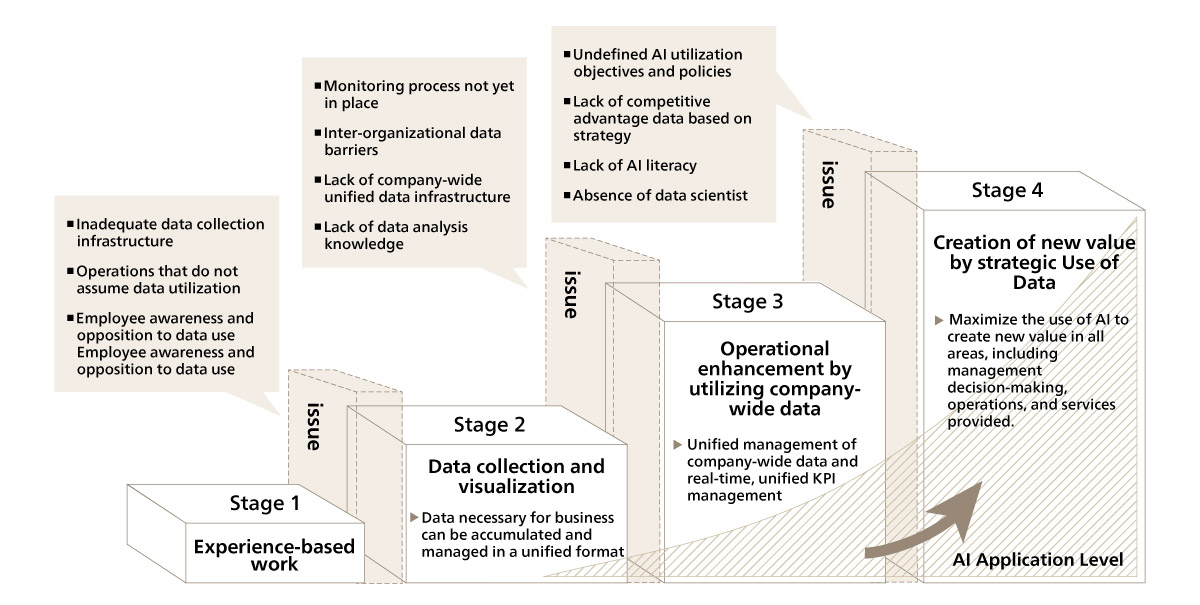
AI Introduction and Utilization Framework
In order to utilize an AI solution, it is essential to clearly define the purpose and method of AI utilization, as well as to consider and prepare various functions necessary to promote AI introduction. Through its support of numerous AI-related projects, ABeam Consulting has organized these functions into a structured framework, ensuring that projects proceed with a focus on minimizing the issues and challenges that may arise during the implementation of these functions.
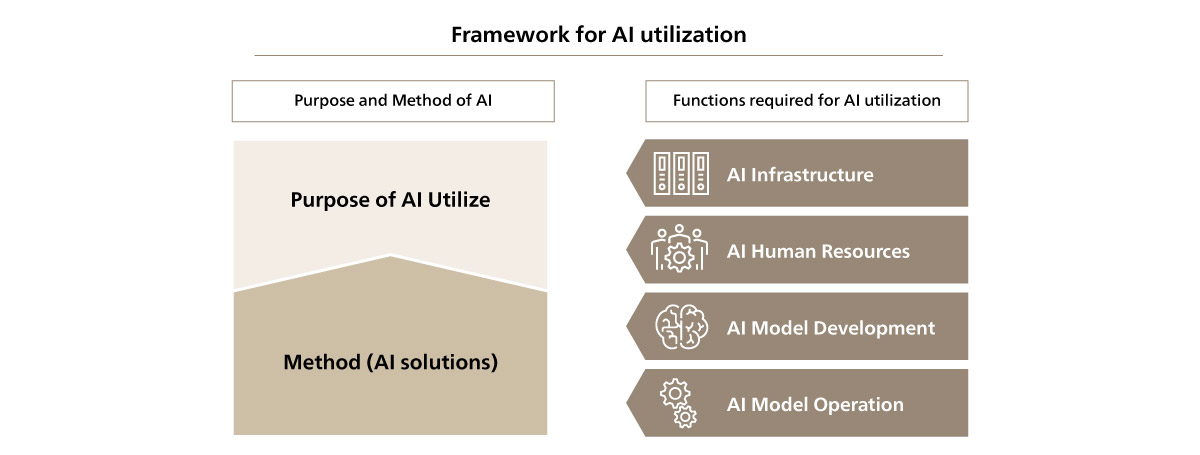
ABeam's AI Solution Overview
As a comprehensive consulting firm for over 40 years, ABeam Consulting has provided consulting services to leading companies across various industries. We offer approximately 30 wide range of solutions that combine in-depth industry knowledge and operational insights with AI as an advanced technology. What is particularly noteworthy is our ability to provide consistent services across all phases, from the upstream phase—such as creating an AI strategy—to the service operation phase, which includes AI development and governance.
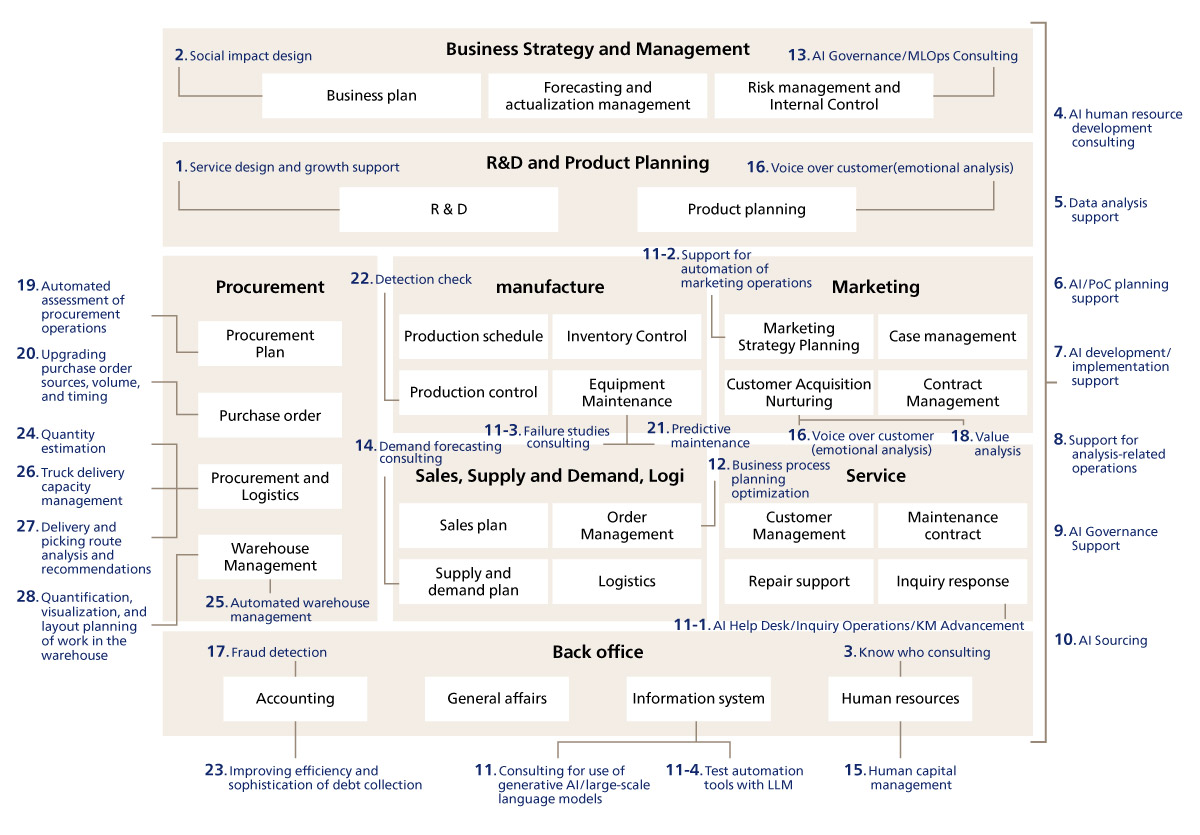
Consider and Prepare various Necessary Functions to Promote AI Introduction
Even if the scope and use cases for AI introduction are clearly defined, in order to promote AI, it is necessary to simultaneously develop functions such as AI infrastructure, AI human resources, and AI model development and operation to ensure long-term success. Without these, the initiative may not be sustainable. It is not always necessary for a company to have all the various functions in-house; depending on the company’s circumstances, it is also important to judge the areas where collaboration with external partners can help achieve its goals.
So far, we have presented the overall ideas and approaches for introducing and utilizing AI. However, in reality, it is essential for each company to identify the business areas suitable for utilizing AI within their own company, considering their unique situation, prioritization strategy, and on-the-ground challenges. Only then should companies begin to concretize specific use cases.
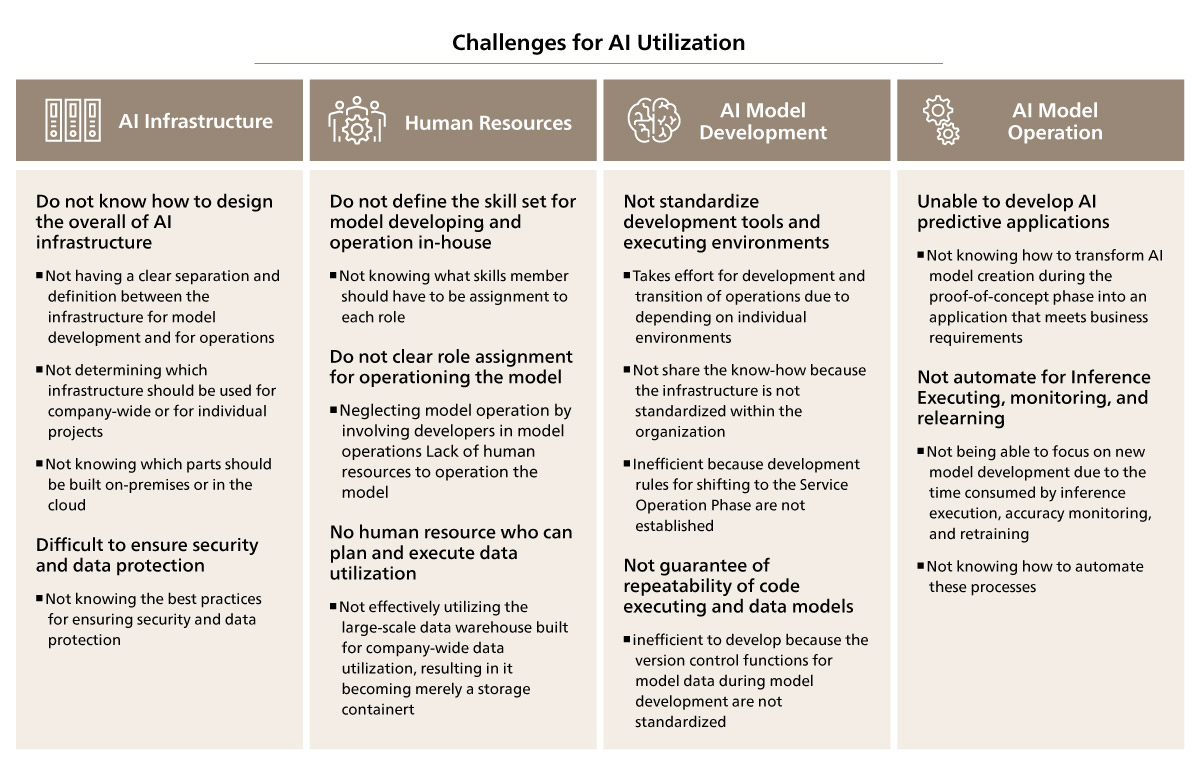
Use case Identification Approach
Deepen your understanding of AI through current trends and an actual AI project. From there, come up with ideas for addressing the specific issues your company faces and explore how AI can be utilized to tackle them. Then, narrow down these ideas into concrete use cases. Next, evaluate how these use cases align with your company’s business and management agenda, assessing their potential impact and effectiveness. Calculate the ROI and develop a deployment plan and roadmap to guide the successful implementation of AI solutions.
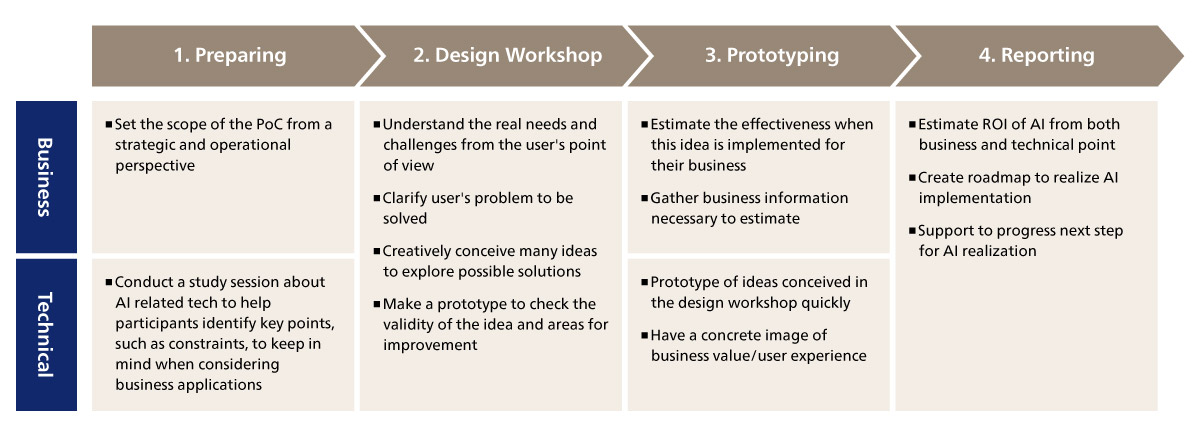
Click here for inquiries and consultations
